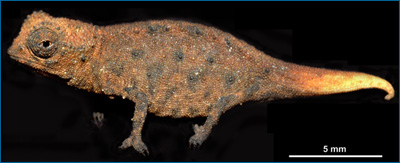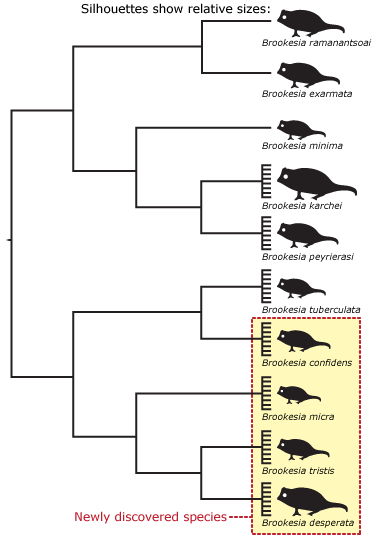
Scientists discover new species all the time, but usually these new species are microbes, plants, insects, and other forms of non-vertebrate life. Few vertebrate species have thus far evaded the curious gaze of biologists intent on understanding the diversity of life on Earth — that is, unless the vertebrate in question happens to be very, very tiny. Last month, scientists announced the discovery of not one, but four miniscule lizard species. The smallest of these new chameleons, which live in the far north of the African island of Madagascar and inhabit leaf litter, reaches an adult body size of just two centimeters. Most popular media stories have focused on the impressively small size of these critters — it’s hard not to coo over an animal that is dwarfed by a matchstick — but the evolutionary story behind the discovery is equally interesting …
Where's the evolution?
This interview with Mark Phuong describes several ways that scientists define species, focusing on ground squirrels as an example. This video is produced by the National Evolutionary Synthesis Center (NESCent) and UCMP.
Evolutionary theory helps us better understand the two central points of this discovery: first, that the lizards actually represent new species, and second, their unusually small size. While it might seem that the discovery of a new species would be cut and dried, that’s not always the case. Species are typically defined as populations that actually or potentially interbreed in nature. To claim that an organism represents a new species, biologists must provide evidence that supports that idea. The new chameleons looked somewhat different from known species and from one another (different body sizes, different length tails, etc.), but of course, some organisms can look quite different from one another and still interbreed — for example, juveniles, males, and females of the same species often have very different appearances. How do we know when an unfamiliar-looking organism is actually a new species?
To help determine whether the chameleons constituted new species, a team of biologists reconstructed their evolutionary history. They sampled the DNA of the new chameleons, compared it to the genetic sequences of similar, known species, and used this information to figure out how all those chameleons are related. If the newly discovered animals are indeed new and distinct species and don’t interbreed with one another or with known species, then we’d expect them each to occupy their own twig of the tree of life. And that’s exactly what the reconstructed evolutionary tree showed. On the tree below, you can see that individuals of the four new species (Brookesia confidens, B. micra, B. tristis, and B. desperata) are all most closely related to other individuals of that species and that they form clades distinct from previously known species.
You can also see from the phylogeny above that one of the newly discovered chameleons, B. micra, is the tiniest of the bunch. In fact, B. micra seems to be one of the very smallest vertebrates on Earth — after some frogs and possibly a dwarf gecko. How did this species (and all the chameleons of the Brookesia clade) wind up so small? Again, evolution helps provide the answer …
Evolutionary biologists have noticed an interesting pattern among organisms that immigrate from a large land mass to an island. Many evolve into miniaturized forms — a phenomenon known as island dwarfism or insular dwarfism. For example, 11,000 years ago, dwarf elephants and hippopotamuses the size of large pigs lived on the island of Cyprus. In such cases, island living seems to have fostered the evolution of small body sizes. However, this pattern doesn’t hold for all organisms: some clades have a tendency to evolve larger body sizes (e.g., common rats and mice, as evidenced by the foot and a half long rats found on the island of Flores), some have a tendency to evolve smaller body sizes (many ungulates), and some don’t change much at all. Why are dwarf forms sometimes more likely to evolve on islands and sometimes not?

In different organisms, changes in body size are likely to have different causes. For example, biologists have hypothesized that in large plant-eating mammals, island dwarfism occurs because of a trade-off between offspring numbers and offspring survival. Small-bodied species generally produce more offspring than large-bodied species, but often have a disadvantage in terms of competing for limited resources and avoiding predation. On an island with little competition for resources and little predation, natural selection favors individuals with a genetic tendency to put more of their energetic resources into producing many offspring than into growing larger body sizes — resulting in a tendency for these species to evolve smaller body sizes. However, on islands where species face competition for resources and predation, individuals with a genetic tendency to divert energy from reproduction and put it towards body growth may be favored. On the other hand, carnivores that immigrate to an island are likely to experience natural selection based on other constraints than those experienced by herbivores. For example, carnivores are usually most effective at subduing prey if they have larger bodies than the prey. This could make carnivores less likely to evolve small body sizes on islands where large prey is available.
It is unclear whether the tiny new chameleon species (which are predators — insect-eaters) represent a case of island dwarfism. They are certainly smaller than their mainland counterparts; however, the patterns and processes of this evolution are not obvious. Interestingly, if island dwarfism is a factor in their small body sizes, the smallest of the small, B. micra, may represent a case of double island dwarfism. This species inhabits a tiny island off the coast of Madagascar called Nosy Hara — so it is possible that the ancestors of the Brookesia chameleons immigrated to Madagascar and evolved small body sizes, and that then the ancestors of B. micra immigrated from Madagascar to Nosy Hara and evolved an even smaller body size! More research will help clarify the evolutionary trajectory of these species.
Unfortunately, time to do that research may be running out. Madagascar has suffered large-scale deforestation, and while recent conservation efforts on the island aim to provide sanctuary for some species, many others have been lost to extinction. The names given to several of the new chameleon species reflect their uncertain future. B. tristis (which means “sorrowful”) and B. desperatus (which means “desperate”) were so named because, despite living in areas currently designated as nature reserves, both are threatened by severe habitat destruction.
Primary literature:
- Glaw, F., Köhler, J., Townsend, T. M., and Vences, M. (2012). Rivaling the world's smallest reptile: discovery of miniaturized and microendemic new species of leaf chameleons (Brookesia) from northern Madagascar. PLoS ONE. 7: e31314. Read it »
News articles:
- A typical brief on the discovery from The Times Colonist
- A short summary of the research from Wired Science
- Photos of the new chameleons from National Geographic
Understanding Evolution resources:
- Species are typically defined as populations that actually or potentially interbreed in nature. What line of evidence described in the article above supports the idea that the chameleons are actually new species? How does it support this idea?
- What other lines of evidence (not described above) would support the idea that the chameleons are new species?
- Review the process of natural selection. Use the four steps described on that page to explain how genes for smaller body sizes might become more common in an animal species that has just migrated to a small island.
- Research and describe an example of island dwarfism not mentioned above.
- Review this common misconception about natural selection. Now imagine that a friend reads the article above and says to you, “Of course, they got smaller. You don’t need to be big when you are living on a tiny island!” How would you correct your friend’s misconception and provide a more accurate description of the chameleons’ evolution?
- Advanced: Review these pages on the biological species concept and other species concepts. Four different species concepts are described there. For each species concept, explain whether or not you think the new chameleons constitute new species by that definition and why, or whether or not you have enough information to tell.
- Teach about phylogenetic classification: In this activity for grades 9-16, students construct an evolutionary tree of imaginary animals (Caminalcules) to illustrate how modern classification schemes attempt to reflect evolutionary history.
- Teach about speciation on islands: In this activity for grades 9-12, students "take a trip" to the Greater Antilles to figure out how the Anolis lizards on the islands might have evolved.
- Teach about natural selection and speciation: This version of the bird beak activity for grades 6-12 teaches students about variation, reproductive isolation, natural selection, and adaptation.
- Glaw, F., Köhler, J., Townsend, T. M., and Vences, M. (2012). Rivaling the world's smallest reptile: discovery of miniaturized and microendemic new species of leaf chameleons (Brookesia) from northern Madagascar. PLoS ONE. 7: e31314.
- Meiri, S., Cooper, N., and Purvis, A. (2008). The island rule: made to be broken? Proceedings of the Royal Society B. 275: 141-148.
- Raia, P., and Meiri, S. (2006). The island rule in large mammals: paleontology meets ecology. Evolution. 60: 1731-1742.

